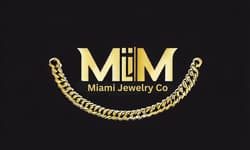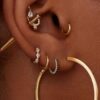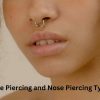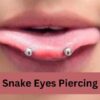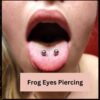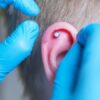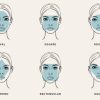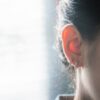Nose Piercing
Nasallang Piercing: Everything You Need to Know
If you have an adventurous spirit and are seeking a way to express your unique personality, the world of body art offers a myriad of options.
One standout choice is the Nasallang piercing. This distinctive and daring piercing isn’t for the faint-hearted, but it certainly is a conversation starter. It provides a bold aesthetic statement and portrays a sense of audacity and individuality.
This comprehensive guide will unveil everything you need to know about the Nasallang piercing.
Contents
- 1 Key Takeaways:
- 2 What is a Nasallang Piercing?
- 3 Where it Came From and Why it’s Popular
- 4 How Do You Get a Nasallang Piercing?
- 5 Importance of Choosing the Right Professional:
- 6 Nasallang Vs Double Nostril Piercings
- 7 Aftercare and Maintenance
- 8 Pros and Cons of Nasallang Piercing
- 9 Pain and Healing Process
- 10 Risks of Nasallang Piercing
- 11 Choosing the Right Jewelry For Nasallang Piercing
- 12 Conclusion
- 13 FAQs
Key Takeaways:
- The Nasallang piercing is special. It goes through both sides of your nose and the middle part too.
- Getting a Nasallang piercing can be hard and may hurt more than other types of piercings. So, you need someone who really knows what they’re doing to do it.
- Looking after your Nasallang piercing once it’s done is very important for it to heal properly. Clean it regularly with a saltwater solution or special cleaning products, stay away from germs, and watch for any problems.
- When picking out jewelry for a Nasallang piercing, choose stuff that won’t cause allergies. Good choices are surgical steel, titanium, or gold. Usually, people use a straight barbell.
- It takes a long time for a Nasallang piercing to heal, about three to four months. Don’t switch out the jewelry until your piercing is completely healed.
In the realm of personal expression and body modification, a well-known saying often comes to mind – “Beauty is pain.” This adage, though perhaps a bit dramatic, resonates particularly when discussing the Nasallang piercing. The pain experienced during the process and the meticulous aftercare routine are priced willingly paid for the unique beauty this piercing offers.
What is a Nasallang Piercing?
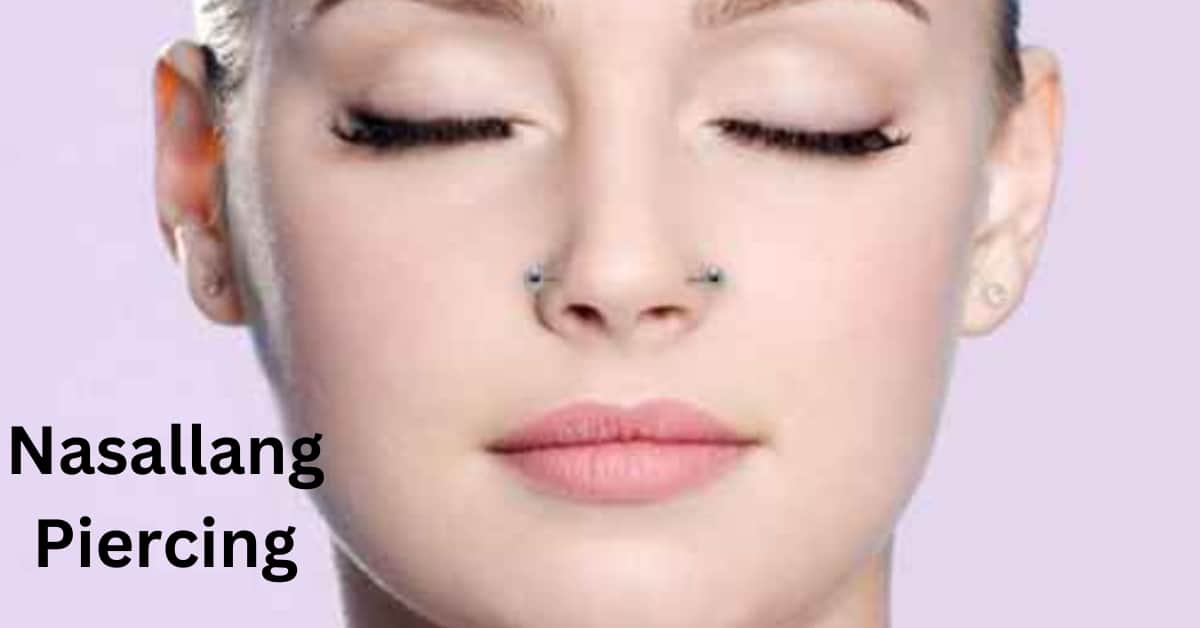
The Nasallang piercing, also called the ‘Tri-nasal piercing’, is a special kind of body art. It goes through your nose in a straight line, going through both nostrils and the middle part of your nose at the same time. This cool way to decorate your body started with certain groups of people a long time ago. Now, it’s become popular with people who love unique and eye-catching body art.
Where it Came From and Why it’s Popular
People in tribes have been changing their bodies in different ways for a very long time, and the Nasallang piercing is part of this history. At first, only these groups did it, but now people all over the world like it. This piercing is a great choice because it combines the balanced look of two nostril piercings with the interesting style of a septum piercing. Its unique look has made it a favorite for people who want something different.
How Do You Get a Nasallang Piercing?
Before we talk about how to get a Nasallang piercing, it’s important to know that it’s not simple. Only someone who really knows what they’re doing should do it. It’s not a regular piercing. The person doing it needs to be very careful and understand exactly what to do to make sure it’s done right and to keep risks low.
Pre-Piercing Preparation
Prior to the piercing process, your piercer will undertake a series of preparatory steps. These steps are crucial in ensuring the piercing is accurate, and that any discomfort during the procedure is minimized.
Firstly, your nose will be thoroughly cleaned to prevent any bacterial contamination. Following this, the piercer will mark the exact entry and exit points for the needle on both nostrils and the septum. These marks act as a roadmap for the piercer, ensuring that the piercing is straight and symmetrical. Remember, precision at this stage is crucial, as it can significantly impact the overall appearance and healing process of your Nasallang piercing.
The Piercing Process
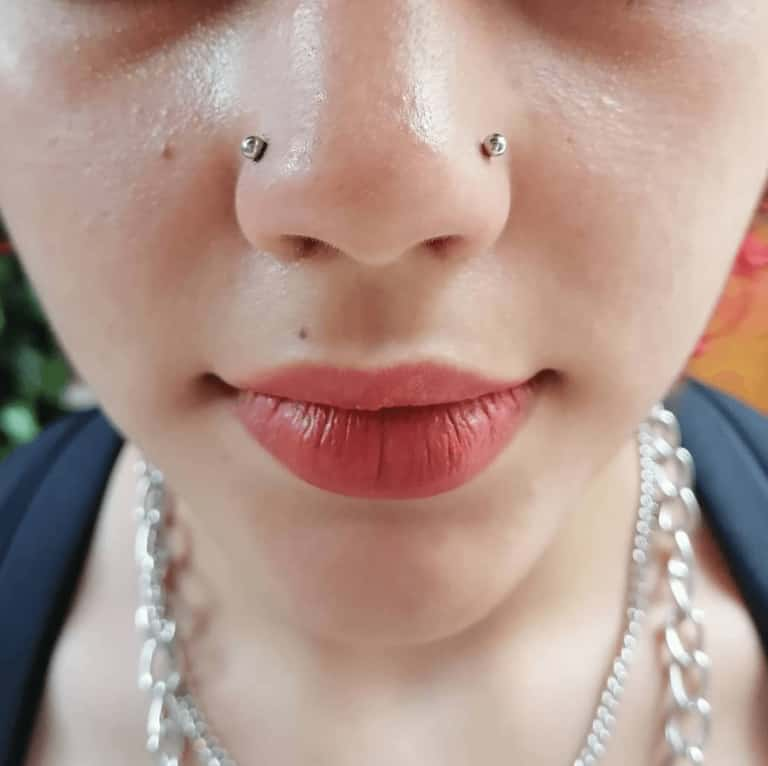
Getting a Nasallang piercing involves a unique process, unlike most other piercings. The procedure requires a single straight needle to pass through the lower part of the septum and both nostrils simultaneously. This swift action can cause considerable discomfort due to the thickness of the tissues being pierced.
Clamping for Stability:
Initially, the piercer may use a clamp to hold your nose steady. This aids in accurately aligning the marked points for piercing.
Needle Puncture:
Following the clamping, a sterilized needle is utilized to puncture through the nostrils and septum. This action creates a straight and symmetrical path for the jewelry.
Immediate Jewelry Insertion:
As soon as the needle has passed through the tissues, the chosen piece of jewelry is immediately inserted. While the overall process is quick, the sensation can be intense due to multiple parts of the nose being pierced at once.
Use of Numbing Spray:
To help minimize discomfort, professional piercers may opt to use a numbing spray prior to the piercing procedure.
Importance of Choosing the Right Professional:
The success of a Nasallang piercing significantly depends on the piercer’s skill level and experience, thus highlighting the importance of selecting an appropriate professional for the task.
- You May Also Like: High Nostril Piercing
Nasallang Vs Double Nostril Piercings
Let’s talk about Nasallang versus double nostril piercings.
Nasallang? It’s a straight shot through both nostrils and the septum, demanding spot-on alignment for a sleek look. It’s bold, it’s symmetrical, and it’s a statement!
Double nostril?
Two separate piercings on one or both nostril sides. You get more wiggle room with placement and jewelry choice. It’s soft, it’s adjustable, and it’s about you! Consider your pain threshold, healing speed, and style preference when deciding. Your nose, your rules!
Aftercare and Maintenance
Proper aftercare is the cornerstone of a successful piercing. It’s instrumental in ensuring a smooth healing process, minimizing the risk of infection, and maintaining the aesthetic appeal of your Nasallang piercing.
Your Daily Piercing Care Routine
Your daily aftercare routine starts right from the moment the piercing is done. The piercer will provide initial care, which includes cleaning the pierced area with a sterile saline solution to clear any potential contaminants.
After that, it’s up to you to keep the piercing clean. Make sure you clean it with a saltwater solution or a special product made just for piercings. You should do this twice a day.
To do it, get a clean cotton ball wet with the solution. Gently press it to your piercing. Be sure not to twist or move your jewelry. This could hurt the new piercing.
Also, always wash your hands before you touch the piercing. This keeps bacteria from getting into it.
What to Avoid During the Healing Process
While your piercing is healing, you need to stay away from certain things. Public pools, lakes, and hot tubs are not safe. They can have bacteria that can get into your piercing.
Also, keep makeup, lotion, and other skin products away from your piercing. These can have stuff in them that might bother your piercing or make it take longer to heal.
Plus, try not to sleep with the piercing pressing into your pillow. This could hurt, or it could move the piercing out of place. To avoid this, sleep on your back or use a travel pillow to take the pressure off your nose.
Signs of Infection or Other Issues
When your piercing is healing, you need to watch it closely. This can help you notice if there’s an infection or other problem early on. It’s normal to see some redness, swelling, mild pain, and a bit of clear or white liquid. But, if these things don’t go away after a week or they get worse, you might have an infection.
Signs of Serious Problems
There are also other signs of trouble. These include really bad pain, a constant burning feeling, yellow or green liquid, a bad smell, or red lines around the piercing. If you see any of these, go to a doctor right away.
Another problem you might see is a bump near your piercing. This is called a “piercing bump” or “keloid”. Usually, these bumps are not a big deal. You can treat them with saltwater soaks and creams. But, if they don’t go away, hurt, or worry you, it’s a good idea to talk to a doctor or the person who did your piercing.
Pro tip: A tip to remember is to do your homework before getting a piercing. Look for someone who is professional and has a lot of experience. This can help lower the chance of your piercing being placed wrong. It also makes sure that the piercing is as safe and easy as it can be.
Pros and Cons of Nasallang Piercing
Before deciding to get a Nasallang piercing, it’s important to weigh the pros and cons. This will help you make an informed decision that you’re comfortable with.
Pros:
Cool Look:
A Nasallang piercing looks different and special. It’s a good way to show who you are.
Saves Money and is Easy to Take Care of:
Even though it’s a three-point piercing, you only need one piece of jewelry. So, it’s not too expensive and it’s easy to clean.
Cons:
It’s Hard and Can Hurt:
Getting a Nasallang piercing can be tough and painful. It goes through a lot of skin so you need a really good piercer to do it.
Takes Time to Heal:
This kind of piercing needs more time to heal than other simple ones. You need to be patient and follow the cleaning rules carefully.
It Can Be Misplaced:
If the piercer doesn’t do it right, the piercing could be in the wrong spot. This can make it look bad and might make healing harder. So, it’s very important to pick a good, skilled piercer for a Nasallang piercing.
Pain and Healing Process
The pain and healing process of a Nasallang piercing is essential considerations to keep in mind before going ahead with this piercing.
Is it Painful?
Everyone feels different when they get a Nasallang piercing. It can feel like a pinch or like a sharp pain. It’s more uncomfortable than other piercings because it goes through lots of skin. But don’t worry, the pain doesn’t last long, and a good piercer can use something to numb the pain.
How Long to Heal and How to Care for It
How long a Nasallang piercing takes to heal can be different for each person. It depends on things like how healthy they are, how they live, and if they take good care of it. Usually, it takes about three to four months to fully heal.
Keep following the cleaning rules all through the time it’s healing. This can help it heal faster and stop problems like infection or bumps from forming.
To help it heal well, eat good food, avoid drinking alcohol and smoking, and get plenty of sleep. These things support your body’s healing process.
Risks of Nasallang Piercing
Like all body changes, there are risks with a Nasallang piercing. Know these risks so you can avoid them and notice any problems early.
Common Risks
The usual risks with a Nasallang piercing are infection and the body rejecting the jewelry. Infections can happen if you don’t clean it well, touch it with dirty hands, or if it’s around bacteria, especially right after getting pierced. Sometimes, your body sees the jewelry as something foreign and tries to push it out. This happens more often if you’re allergic to some metals.
How to Avoid Risks
To avoid these risks, keep the piercing very clean while it’s healing. Clean it often with a saltwater solution, don’t touch it with dirty hands, and stay away from public pools and places with lots of bacteria. Choosing jewelry that doesn’t cause allergies can also lower the chance of your body rejecting it.
Choosing the Right Jewelry For Nasallang Piercing
The jewelry you choose for your Nasallang piercing not only impacts the overall look of your piercing but also plays a role in the healing process. Thus, it’s essential to choose the right type, size, and material of jewelry.
What Type of Jewelry is Typically Used
The most common type of jewelry used for a Nasallang piercing is a straight barbell. It’s crucial that the barbell is long enough to accommodate any initial swelling that may occur after the piercing. Once the swelling subsides and the piercing is healed, you can switch to a shorter barbell if you prefer.
How to Choose the Right Material and Size
When it comes to the material of the jewelry, it’s best to stick to hypoallergenic materials such as surgical steel, titanium, or gold. These materials minimize the risk of allergic reactions and are safe for long-term wear.
The size of the jewelry should be chosen based on the thickness and anatomy of your nose. Your piercer can help you determine the right size for your anatomy.
When and How to Change the Jewelry
Changing your jewelry too soon after the piercing can lead to complications such as irritation, delayed healing, or even infection. Therefore, it’s recommended to wait until the piercing is fully healed before changing the jewelry. This generally takes around three to four months.
When it’s time to change your jewelry, it’s advisable to do it in a clean environment, using clean hands and tools. You can also ask your piercer to change it for you to ensure it’s done correctly and safely.
Further Reading for Piercing Enthusiasts:
- How to Take Out a Labret Nose Stud
- 18g vs 20g Nose Rings: Which One is Right for You?
- How to Wear Half Hoop Nose Ring
- L-Shaped Nose Rings Vs Screw
- How to Put in a Nose Ring with a Hook
- How to Take Out Nose Stud with Flat Back
- Types of Nose Rings
- How to Put in a Double Hoop Nose Ring
- How To Reopen A Closed Nose Piercing
- What Does A Nose Ring Mean On A Woman
Conclusion
The Nasallang piercing is a bold and unique body modification that lets you stand out from the crowd. It’s not a decision to be taken lightly, considering its complexity, potential risks, and the commitment required for aftercare. However, with the right professional, correct aftercare practices, and suitable jewelry, a Nasallang piercing can be a gratifying way to express your individuality.
FAQs
What is a nasallang piercing?
A Nasallang piercing is a tri-nasal modification using one jewelry piece through both nostrils and septum. It provides a symmetrical, bold aesthetic. Precision and aftercare are vital for a seamless look and proper healing.
How bad does a nasallang piercing hurt?
Pain from a nasallang piercing varies. Some people may find it more painful because it goes through three parts of the nose. Always go to a professional to lessen the pain.
How painful is a septum piercing?
Pain from a septum piercing depends on the person. Some people describe it as a pinch. The pain usually fades soon after getting the piercing.
What are the risks of nose piercing?
Nose piercings can have some risks. These include infection, allergy, injury, or the body rejecting the jewelry. Risks can be lessened by taking good care of the piercing and using quality jewelry.
What are the top 3 most painful piercings?
Pain from piercings depends on the person. However, many find daith, rook, and nipple piercings painful. These areas are thick and sensitive, so they may hurt more.
What is the hardest piercing to heal?
Piercings that take the longest to heal are often in areas with lots of movement or thick skin. For example, rook or industrial piercings. The nasallang piercing can also take time to heal because it goes through three parts of the nose. To help with healing, keep the area clean and try not to move it too much.
Is a Nasallang piercing more painful than other piercings?
The pain level of a Nasallang piercing tends to be higher than other piercings due to the multiple layers of tissue involved. However, everyone’s pain tolerance is different, and what might be painful for one person might not be for another.
How long does it take for a Nasallang piercing to heal?
A Nasallang piercing typically takes around three to four months to fully heal. However, this can vary based on your individual health, lifestyle, and how well you follow the aftercare routine.
Is a Nasallang piercing suitable for everyone?
Not everyone can get a Nasallang piercing. Individuals with certain nasal structures or health conditions may not be suitable candidates. It’s important to discuss this with a professional piercer during your consultation.

Camila Luna is a passionate jewelry enthusiast and content creator at Miami Jewelry Co. With a focus on providing high-quality, Miami-style jewelry, Camila and her team specialize in a wide range of jewelry that includes bracelets, necklaces, earrings, and more
